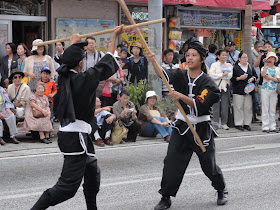 O has a viral infection that keeps her from hanging out with other kids right now. So we decided that the best way to get her out of the house today was to go see one of the local tourist sites. We chose the Nakamura House.
O has a viral infection that keeps her from hanging out with other kids right now. So we decided that the best way to get her out of the house today was to go see one of the local tourist sites. We chose the Nakamura House.Nakamura House is a traditional Okinawan style house, dating from the 18th century, when it served as the residence of the Nakmura family. Nakamura House has been designated a major cultural asset by the Japanese government and is open to the public. (See below for some brochure information)
There are several really nice aspects to going to the Nakamura House. One, it is only a couple km down the road from Camp Foster which makes it very convenient for us to get to. Two, it is set back away from any major streets and is secluded from the surrounding houses. So the atmosphere is very laid back and relaxing. Time literally seems to slow down and you become more calm. Three, the house is so well preserved and furnished as if someone still lived there that you can really get a feel for the residence and how it's inhabitants would have spent their days. Lastly, if you aren't ready to go home when you're done looking around, Nakagusuku Castle is just a little farther down the road.
Upon arriving, we approached an old house with a pond out front. The bottom level was a gift shop where you purchase your entry tickets. We found out later that your entry fee includes complimentary hot or cold tea and sugar cane jelly that is served at the tables inside the gift shop. (O liked the jelly so much the hostess gave us the recipe. See below.) You are also able to purchase a few noodle dishes and some other foods. I think next time we'll eat our lunch here. The food looked and smelled really good. I'll definitely bring more yen too. The gift shop was awesome and offered a large variety of items. They sell fish food too if you want to feed the koi out front.
We wandered around the house looking into each of the rooms and seeing a flashback into another era. All the equipment used for stabling the animals were on display, the kitchen was set up and stocked with pots and pans as if someone were going to cook dinner later on, each room was furnished with tables, chests, laquerware, etc that was appropriate to its function, and even the alters were ready to be prayed at.
 Before returning to the gift shop, we walked the stone pathway around the house which actually winds up and down the walls through a narrow garden mostly level with the rooftop. This change in viewpoint really offers a great way to experience the house from another perspective... although I'm not sure how nice it would have been if the house was still a working farm due to the rising odors from the pig pen and horse stables... but I suppose you would be used to those. :D
Before returning to the gift shop, we walked the stone pathway around the house which actually winds up and down the walls through a narrow garden mostly level with the rooftop. This change in viewpoint really offers a great way to experience the house from another perspective... although I'm not sure how nice it would have been if the house was still a working farm due to the rising odors from the pig pen and horse stables... but I suppose you would be used to those. :DNakamura House Info:
Open 0900-1730 everyday except holidays.
Adults 500 yen, 12-18 300 yen, under 12 200 yen.
Groups of 20+: Adults 450 yen, 12-18 270 yen, under 12 180 yen.
Some Brochure Info:
Family History:
The history of the Nakamura family dates back to the early part of the 15th century when Gahi, an ancestor of the family, moved his residence to Nakagusuku from Zakimi in Yomitan. The reason for the move was because Lord Gosamaru of Zakimi had received an order from the king in Shuri to relocate his castle to Nakagusuku. Gashi served as Gosamaru's teacher until his downfall at the hands of Lord Amawari of Katsuren Castle.
With the Nakagusuku Castle in ruins, Gashi and his family also suffered from their lord's adversity. It was not until 1720 that fortune came back to the Nakamura family when one of the ancestors was called upon to serve as a Jitoshoku (village headman) by the royal government in Shuri. It was around this time when the first foundations of the Nakamura house was set in.
Structure:
The Nakamura house is a typical style of a rich farmer's residence. The basic structural method dates back to houses found in mainland Japan between the Kamakura and Muromachi periods (1185-1572). The house was originally of thatched roof and it was not until the time of the 7th generation when it was reroofed using the Okinawa traditional red tiles. This reflects the rising social standard of the Nakamura family since rigid regulations at the time restricted commoners' homes in size and appearance.
 Brown Sugar Jelly Recipe (word for word from the paper)
Brown Sugar Jelly Recipe (word for word from the paper)Materials: Brown Sugar 100g, Water 500ml, Gelatin powder 10g, soybean flour with liking
1. Brown sugar and water are put into a pan and it applies to fire.
2. If brown sugar melts, fire is put out, and gelatin will be added and it will melt.
3. 2 is put into a container and a refrigerator cools.
4. It is completion, when dishing up in the vessel put into mind and covering soybean flour.















































